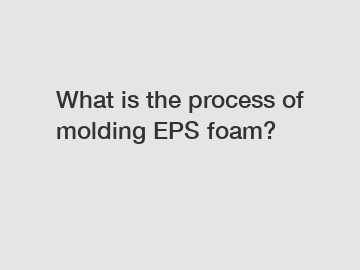What is the process of molding EPS foam?
What is the Process of Molding EPS Foam?
EPS foam, also known as expanded polystyrene foam, is a versatile material often used in various industries for insulation, packaging, and even construction. Molding EPS foam involves a specific process that transforms it into different shapes and sizes. This article will explore the process of molding EPS foam, highlighting its key steps and benefits.
EPS foam starts as small beads of polystyrene, which are then expanded and molded into the desired shape. The molding process allows for the creation of intricate and complex designs, making it ideal for a wide range of applications. The versatility and lightweight nature of EPS foam make it a popular choice in industries such as packaging, automotive, and construction.

Key Steps in the EPS Foam Molding Process.
1. Pre-expansion: The initial step in molding EPS foam is the pre-expansion of the raw material. The polystyrene beads are heated, causing them to expand and fill with gas. This expansion creates the characteristic closed-cell structure of EPS foam, providing it with excellent thermal insulation properties.
2. Drying: Once the beads have expanded, they undergo a drying process. This step ensures that the beads are free of moisture and ready for the next stage of the molding process.
3. Bead Conditioning: The expanded EPS foam beads are then conditioned to achieve consistent density and improve their flowability. This process involves sieving to remove any excess debris or non-expanded beads.
4. Molding and Shape Formation: The conditioned EPS foam beads are placed into a mold and subjected to steam and pressure. The steam softens the beads, allowing them to bind together and take the shape of the mold. The pressure ensures that the beads compact evenly and form a solid and durable finished product.
5. Cooling and Demolding: After the molding process, the formed EPS foam product is cooled to solidify its shape. Once cooled, the product is carefully removed from the mold, revealing the desired configuration. This step requires precision to avoid any damage to the foam.
Benefits of EPS Foam Molding.
EPS foam molding offers a range of benefits, making it a popular choice in various industries:
1. Thermal Insulation: EPS foam's closed-cell structure provides exceptional thermal insulation, making it ideal for applications where temperature control is crucial, such as packaging perishable goods or insulating buildings.
2. Lightweight and Durable: EPS foam is lightweight compared to other materials, making it easier to handle and transport. Despite its lightweight nature, it is highly durable and resistant to moisture, chemicals, and impact.
3. Design Flexibility: The molding process allows for design flexibility, enabling the creation of intricate and complex shapes. This makes EPS foam suitable for a wide range of applications, including packaging inserts, architectural moldings, and automotive components.
Conclusion.
The process of molding EPS foam is a precise and controlled operation that transforms raw polystyrene beads into versatile and functional products. With its excellent thermal insulation properties, lightweight nature, and design flexibility, EPS foam has become a go-to choice for many industries. Whether it's for packaging, construction, or automotive applications, EPS foam offers numerous advantages.
If you are looking for high-quality EPS foam molding services or have any inquiries, please do not hesitate to contact us. Our team of experts is ready to assist you in finding the best solutions for your needs.
The company is the world’s best 2L jerry can blow molding machine, helmet injection machine injection molding machine machinery, turnover box injection mould oil supplier. We are your one-stop shop for all needs. Our staff are highly-specialized and will help you find the product you need.


